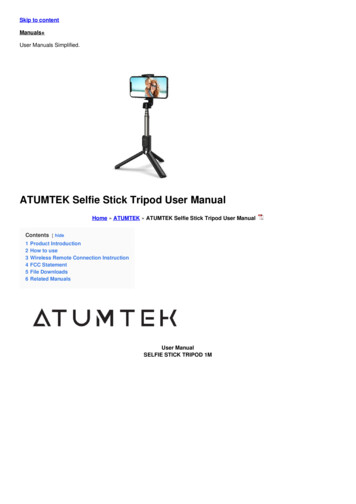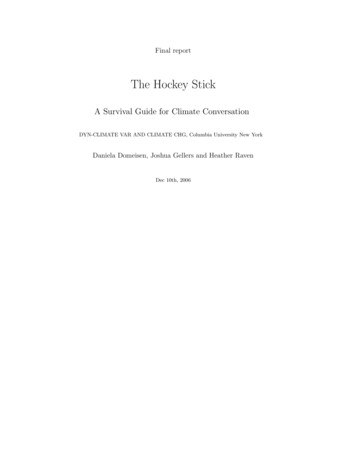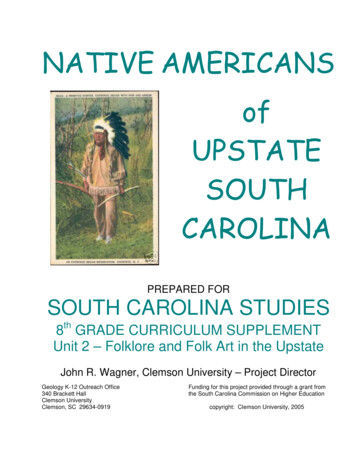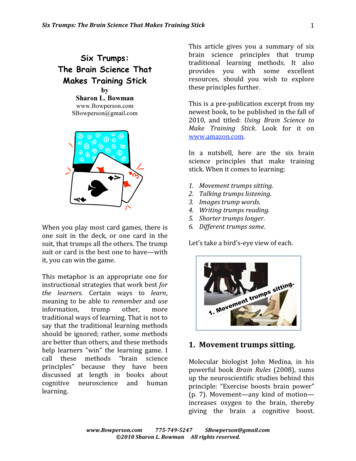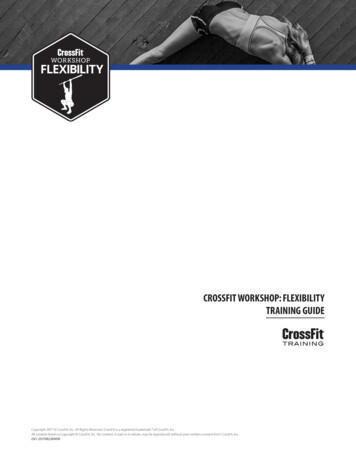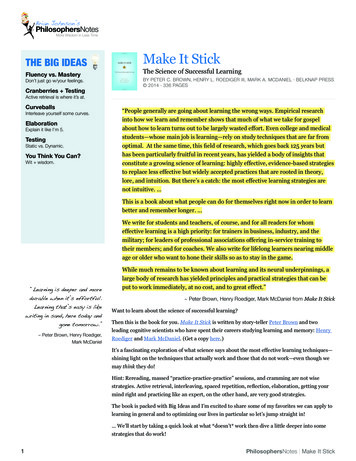
Transcription
Brian Johnson’sPhilosophersNotesTMMore Wisdom in Less TimeTHE BIG IDEASFluency vs. MasteryDon’t just go w/your feelings.Cranberries TestingMake It StickThe Science of Successful LearningBY PETER C. BROWN, HENRY L. ROEDIGER III, MARK A. MCDANIEL · BELKNAP PRESS 2014 · 336 PAGESActive retrieval is where it’s at.CurveballsInterleave yourself some curves.ElaborationExplain it like I’m 5.TestingStatic vs. Dynamic.You Think You Can?Wit wisdom.“People generally are going about learning the wrong ways. Empirical researchinto how we learn and remember shows that much of what we take for gospelabout how to learn turns out to be largely wasted effort. Even college and medicalstudents—whose main job is learning—rely on study techniques that are far fromoptimal. At the same time, this field of research, which goes back 125 years buthas been particularly fruitful in recent years, has yielded a body of insights thatconstitute a growing science of learning: highly effective, evidence-based strategiesto replace less effective but widely accepted practices that are rooted in theory,lore, and intuition. But there’s a catch: the most effective learning strategies arenot intuitive. .This is a book about what people can do for themselves right now in order to learnbetter and remember longer. .We write for students and teachers, of course, and for all readers for whomeffective learning is a high priority: for trainers in business, industry, and themilitary; for leaders of professional associations offering in-service training totheir members; and for coaches. We also write for lifelong learners nearing middleage or older who want to hone their skills so as to stay in the game.“Learning is deeper and moreWhile much remains to be known about learning and its neural underpinnings, alarge body of research has yielded principles and practical strategies that can beput to work immediately, at no cost, and to great effect.” Peter Brown, Henry Roediger, Mark McDaniel from Make It Stickdurable when it’s effortful.Learning that’s easy is likewriting in sand, here today andgone tomorrow.” Peter Brown, Henry Roediger,Mark McDanielWant to learn about the science of successful learning?Then this is the book for you. Make It Stick is written by story-teller Peter Brown and twoleading cognitive scientists who have spent their careers studying learning and memory: HenryRoediger and Mark McDaniel. (Get a copy here.)It’s a fascinating exploration of what science says about the most effective learning techniques—shining light on the techniques that actually work and those that do not work—even though wemay think they do!Hint: Rereading, massed “practice-practice-practice” sessions, and cramming are not wisestrategies. Active retrieval, interleaving, spaced repetition, reflection, elaboration, getting yourmind right and practicing like an expert, on the other hand, are very good strategies.The book is packed with Big Ideas and I’m excited to share some of my favorites we can apply tolearning in general and to optimizing our lives in particular so let’s jump straight in!. We’ll start by taking a quick look at what *doesn’t* work then dive a little deeper into somestrategies that do work!1PhilosophersNotes Make It Stick
FEELINGS OF FLUENCY VS. TRUE MASTERY“Where more cognitive effortis required for retrieval,greater retention results.” Peter Brown, Henry Roediger,Mark McDaniel“Learning is deeper and more durable when it’s effortful. Learning that’s easy is like writing insand, here today and gone tomorrow.We are poor judges of when we are learning well and when we’re not. When the going is harderand slower and it doesn’t feel productive, we are drawn to strategies that feel more fruitful,unaware that the gains from these strategies are often temporary.Rereading text and massed practice of a skill or new knowledge are by far the preferred studystrategies of learners of all stripes, but they’re also among the least productive. By massedpractice we mean the single-minded, rapid-fire repetition of something you’re trying to burninto memory, the ‘practice-practice-practice’ of conventional wisdom. Cramming for exams is anexample. Rereading and massed practice give rise to feelings of fluency that are taken to be signsof mastery, but for true mastery or durability these strategies are largely a waste of time.”Conventional wisdom tells us the most effective ways to study and learn involves tons ofhighlighting, rereading and “massed practice”—focusing on one topic deeply until you totally getit (or, at least *feel* like you get it).The authors come back to the fact that, although these approaches are the most prevalent andfeel good as you do them, they are also the least effective.They make the important point throughout the book (via an effective learning strategy called“spaced repetition”), that there’s a (huge!!) difference between “fluency” with a topic—a feelingof familiarity—and true mastery of that topic.To get true mastery and “make it stick,” we need to engage in more effective strategies.Let’s take a quick look at a few of my favorites!CRANBERRIES THE TESTING EFFECT“Empirical research shows“A child stringing cranberries on a thread goes to hang them on the tree, only to find they’veus that the testing effect isslipped off the other end. Without the knot, there’s no making a string. Without the knot,real—that the act of retrievingthere’s no necklace, there’s no beaded purse, no magnificent tapestry. Retrieval ties the knot fora memory changes thememory, making it easier toretrieve again later.” Peter Brown, Henry Roediger,Mark McDanielmemory. Repeated retrieval snugs it up and adds a loop to make it fast. .Today, we know from empirical research that practicing retrieval makes learning stick farbetter than reexposure to the original material does. This is the testing effect, also known as theretrieval-practice effect.To be most effective, retrieval must be repeated again and again, in spaced out sessions so thatthe recall, rather than becoming a mindless recitation, requires some cognitive effort. Repeatedrecall appears to help memory consolidate into a cohesive representation in the brain and tostrengthen and multiply the neural routes by which the knowledge can later be retrieved.”That’s from the chapter, “To Learn, Retrieve.” It’s the first Idea the authors share on how tomake it stick.They make the important point that mindlessly rereading material DOES NOT lead to mastery.But. Practicing retrieving the material DOES lead to mastery.It’s a lot harder to close the book and ask yourself what you just learned than it is to simply scanyour highlights and, as we discussed in the last Idea, FEEL like you have a sense of mastery(which is really just fluency).So, the lesson is clear: If we want to master material and tie the ol’ knot to keep those cranberriesfrom slipping off, we need to test ourselves.2PhilosophersNotes Make It Stick
Quick quiz: What have you learned so far in this Note? Without going back and reviewing, make“If it’s important, it needsto be practiced, and practicedagain. And don’t put stocka mental (or actual!) note of the key Ideas we’ve explored so far.Here are some of the main Ideas I’ve gleaned thus far:in momentary gains thatresult from massed practice.Space your testing, vary yourpractice, keep the long view.” Peter Brown, Henry Roediger,Mark McDanielTHAT is active retrieval.It’s not particularly comfortable and it “feels” like you haven’t understood as much as you’dlike. Although it would “feel” better to just go back to the top and re-read stuff, the act of testingyourself gives your little neurons a workout and helps us MAKE IT STICK.It’s kinda like going to the gym and just lifting Styrofoam weights (rereading) vs. lifting theheavy stuff (retrieving)—one leads to strength development and the other does not.Remember: Testing itself is a form of learning. So. After reading a great book or watching aTED talk or reading/listening to one these Notes, try quizzing yourself on what you remember!(And, of course, support your kids with this process as well!)INTERLEAVE YOURSELF SOME CURVEBALLS“When the baseball players at Cal Poly practiced curveball after curveball over fifteen pitches,it became easier for them to remember the perceptions and responses they needed for thattype of pitch: the look of the ball’s spin, how the ball changed direction, how fast its directionchanged, and how long to wait for it to curve. Performance improved, but the growing ease ofrecalling those perceptions and responses led to little durable learning. It is one skill to hit acurveball when you know a curveball will be thrown, it is a different skill to hit a curveball whenyou don’t know it’s coming. Baseball players need to build the latter skill, but they often practicethe former, which, being a form of massed practice, builds performance gains on short-termmemory. It was more challenging for the Cal Poly batters to retrieve the necessary skills whenpractice involved random pitches. Meeting that challenge made the performance gains painfullyslow but also long lasting.”That’s from a chapter called “Embrace Difficulties” in which the authors chat about “desirabledifficulties.” — “Short-term impediments that make for stronger learning.”We talked about desirable difficulties in our Note on Malcolm Gladwell’s David and Goliath.“We acknowledge thateveryone has learningpreferences, but we are notpersuaded that you learnbetter when the mannerof instruction fits thosepreferences.” Peter Brown, Henry Roediger,Mark McDanielHere’s what he shared: “The CRT is really hard. But here’s the strange thing. Do you knowthe easiest way to raise people’s scores on the test? Make it just a little bit harder. Thepsychologists Adam Alter and Daniel Oppenheimer tried this a few years ago with a groupof undergraduates at Princeton University. First they gave the CRT the normal way, and thestudents averaged 1.9 correct answers out of three. That’s pretty good, though it is well shortof the 2.18 that MIT students averaged. Then Alter and Oppenheimer printed out the testquestions in a font that was really hard to read—a 10 percent gray, 10-point italics Myriad Profont—so it looked like this:1. A bat and ball cost 1.10 in total. The bat costs 1.00 more than the ball. How much does theball cost?The average score this time around? 2.45. Suddenly, the students were doing much better thantheir counterparts at MIT.That’s strange, isn’t it? Normally we think that we are better at solving problems when theyare presented clearly and simply. But here the opposite happened.”Just making something a little harder actually IMPROVED performance. Fascinating.PhilosophersNotes Make It Stick3
“Practice like you play,because you will play like youpractice.” Peter Brown, Henry Roediger,Mark McDanielDesirable difficulties.Back to our Cal Poly baseball players. The authors share a study in which the team is split upsuch that some players practice hitting curveball after curveball after curveball (called “massedpractice”) while others are thrown random pitches (“interleaved” practice).As per our growing theme, the curveball curveball curveball curveball batters FELT(and looked) like they were getting better and better. But their gains were based on short-termmemory not true, deep learning.On the other hand, the batters facing random pitches had to work a lot harder to identifywhat pitch was coming and respond to it appropriately. — “Meeting that challenge made theperformance gains painfully slow but also long lasting.”The technical terms for this: “massed practice” vs. “interleaved practice.”Massed practice is how we typically approach learning—whether it’s via curveballs or mathproblems—we work through a set of similar problems until we attain a perceived level of masteryand then move on.Interleaved practice, on the other hand, is a much better course to mastery. Whether it’s mixingup the types of pitches we’re facing or the types of math problems we’re solving, we want to keepourselves on our toes and not make it too easy.Counterintuitive but remember (echo!): Easier isn’t better.P.S. As I banged out my burpees this morning interval-style (10 in 40 seconds then 20 secondrest 100 total burpees in 10 minutes), I had the thought that interleaving practice is kindalike interval training. It’s *much* easier to go for a jog (or whatever) at a steady state than it is tobust out x intervals of high intensity followed by quick recovery. AND. It’s much more effectiveconditioning to do the interval training.ELABORATION EXPLAIN IT LIKE I’M 5“In a cartoon by the Far Side cartoonist Gary Larson, a bug-eyed school kid asks his teacher, ‘Mr.Osborne, can I be excused? My brain is full!’ If you’re just engaging in mechanical repetition,it’s true, you quickly hit the limit of what you can keep in mind. However, if you practiceelaboration, there’s no known limit to how much you can learn. Elaboration is the process ofgiving new material meaning by expressing it in your own words and connecting it with what youalready know. The more you can explain about the way your new learning relates to your priorknowledge, the stronger your grasp of the new learning will be, and the more connections youcreate that will help you remember it later.”Elaboration. (I love this one.)Let’s do another quick, practical check in: What’s your favorite Big Idea we’ve ever explored?The one that’s had the most positive impact on your life so far?Explain it in your own words and connect it to other wisdom in that wonderful mind of yours!That technique is called elaboration. It’s one of the most effective (and fun!) ways to learn.— Say it in your own words. Connect it to something you already know.Remember: There’s NO (!) known limit to what you can learn when you connect a new piece ofinformation to an existing memory.P.S. Another facet of elaboration is explaining an Idea to people—which reminds me of a gemfrom Barbara Oakley’s A Mind for Numbers (check out that Note plus her class Learning How toLearn—which is one of the biggest classes in history with 1 million students!).4PhilosophersNotes Make It Stick
“How ably you can explaina text is an excellent cuefor judging comprehension,because you must recall thesalient points from memory,put them into your ownwords, and explain why theyare significant—how theyrelate to the larger subject.” Peter Brown, Henry Roediger,Mark McDanielHere’s how Barbara puts it: “The legendary Charles Darwin would do much the same thing.When trying to explain a concept, he imagined someone had just walked into his study. Hewould put his pen down and try to explain the idea in the simplest terms. That helped himfigure out how he would describe the concept in print. Along those lines, the website Reddit.com has a section called ‘Explain like I’m 5’ where anyone can make a post asking for a simpleexplanation of a complex topic.You may think you really have to understand something in order to explain it. But observewhat happens when you are talking to other people about what you are studying. You’ll besurprised to see how often understanding arises as a consequence of attempts to explain toothers and yourself, rather than the explanation arising out of your previous understanding.This is why teachers often say that the first time they ever really understood the material waswhen they had to teach it.”Want to see if you’ve mastered something?Explain it like I’m 5. :)STATIC VS. DYNAMIC TESTING“Sternberg’s concept of developing expertise holds that with continued experience in a field weare always moving from a lower state of competence to a higher one. His concept also holds thatstandardized tests can’t accurately rate our potential because what they reveal is limited to astatic report of where we are on the learning continuum at the time the test is given. In tandemwith Sternberg’s three-part model of intelligence, he and Grigorenko have proposed a shift awayfrom static tests and replacing them with what they call dynamic testing: determining the stateof one’s expertise; refocusing learning on areas of low performance; follow-up testing to measurethe improvement and to refocus learning so as to keep raising expertise. Thus, a test may assessa weakness, but rather than assuming that the weakness indicates a fixed inability, you interpretit as a lack of skill or knowledge that can be remedied.”This is part of a longer conversation, but I want to quickly highlight something important here.Although the book is deliberately about how individuals can optimize their learning not how“In Sternberg’s view, we’reall in a state of developingexpertise, and any test thatmeasures only what weknow at any given momentis a static measure thattells us nothing about our*potential* in the realm thetest measures.” Peter Brown, Henry Roediger,Mark McDanielsocieties can optimize their approaches to education, the authors make the important point thatstandardized tests are simply STATIC measures of current abilities in a particular domain. Theydo *not* predict our potential in the area tested—whether that’s reading or math or IQ—nor dothey reveal our overall effective intelligence.Robert Sternberg is one of the world’s leading researchers on what he calls “successfulintelligence” and his work establishes the fact that success isn’t about IQ. It’s about optimizingthree aspects of successful intelligence: analytical creative practical intelligences.And, he makes the point that the best way to do that is NOT via standard, static testing but viawhat he calls dynamic testing in which weaknesses are revealed and then worked on and thenretested and optimized. Static vs. dynamic testing. Big difference.This idea that intelligence is both broader than it is currently defined and more malleable thanbelieved leads us to our final Big Idea:YOU THINK YOU CAN?“Let’s return to the old saw ‘If you think you can, or you think you can’t, you’re right.’ It turnsout there is more truth here than wit. Attitude counts for a lot. The studies of psychologist CarolDweck have gotten huge attention for showing just how big an impact one simple conviction canhave on learning and performance: the belief that your level of intellectual ability is not fixed butrests to a large degree in your own hands. .PhilosophersNotes Make It Stick5
Dweck’s research has been triggered by her curiosity over why some people become helplesswhen they encountered challenges and fail at them, whereas others respond to failure by trying“Are there strategies orbehaviors that can serve ascognitive ‘multipliers’ toamp up the performance ofnew strategies and redoubling their effort. She found that a fundamental difference between thetwo responses lies in how a person attributes their failure: those who attribute failure to theirown inability—‘I’m not intelligent’—become helpless. Those who interpret failure as the result ofinsufficient effort or an ineffective strategy dig deeper and try different approaches.”the intelligence I’ve alreadyThat’s from a chapter on how to “Increase Your Abilities.” As you’ve probably noticed by now,got? Yes. Here they are:it’s impossible to study nearly ANY topic related to optimizing and actualizing and not rub upembracing a growth mindset,against Carol Dweck’s research. (Check out our Notes on Mindset and Self-theories.)practicing like an expert, andFor now, what do you want to master in your life? Is it a particular subject? Or building a newconstructing memory cues.” Peter Brown, Henry Roediger,Mark McDanielhabit? Or achieving success in your business or new coaching practice or whatever?Whatever it is, do you think you can do it? There’s as much wisdom as wit to Henry Ford’s adagethat whether we think we can or think we can’t WE’RE RIGHT.This Idea plays a huge role in Piers Steel’s Procrastination Equation as well (see Notes). Aswe’ve discussed, Steele tells us that our motivation is a function of wanting something ANDbelieving you can have it.Short story: If you don’t think you can you’ll be pulled off track and procrastinate.So, as we get out there and tie the knot in our string of cranberries while interleaving curveballsand explaining it like I’m 5, let’s remember it all starts with KNOWING that we can improve ourabilities if we’re willing to put in the effort and persist.To optimizing and actualizing and making it stick!Brian JohnsonIf you liked this Note,you’ll probably like A Mind for NumbersThe Talent CodeAbout the Author of “Make It Stick”PETER BROWN, HENRY ROEDIGER, MARK MCDANIELPeter C. Brown is a writer and novelist in St. Paul, Minnesota.Connect: makeitstick.net.MindsetSelf-theoriesThe Power of HabitHenry L. Roediger III is James S. McDonnell Distinguished University Professorof Psychology at Washington University in St. Louis.Mark A. McDaniel is Professor of Psychology and Director of the Center forIntegrative Research on Cognition, Learning, and Education (CIRCLE) atWashington University in St. Louis.About the Author of This NoteBRIAN JOHNSONBrian Johnson loves helping people optimize their lives as he studies, embodiesand teaches the fundamentals of optimal living—integrating ancient wisdom modern science common sense virtue mastery fun. Learn more andoptimize your life at brianjohnson.me.6PhilosophersNotes Make It Stick
Peter Brown, Henry Roediger, Mark McDaniel from Make It Stick Want to learn about the science of successful learning? Then this is the book for you. Make It Stick is written by story-teller Peter Brown and two leading cognitive scientists who have spent their careers studying learning and memory: Henry Roediger and Mark McDaniel. (Get a copy .


